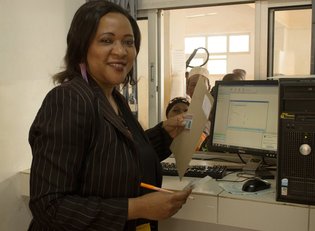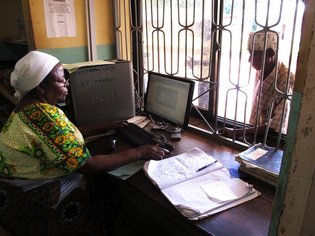A Computer Assisted Hospital Management System increases revenue and improves services
Since hospitals in Tanga region introduced a computer-assisted hospital management system, longstanding problems in patient registration, revenue collection and drug procurement have been resolved.
In the last three years the Tanzanian-German Programme to Support Health under the leadership of the Ministry of Health and supported by GIZ on behalf of Germany’s Federal Ministry for Economic Cooperation and Development (BMZ), has assisted the hospitals in Tanga region in introducing a Computer Assisted Hospital Management System (CAHMS), providing IT hardware, the ‘Afya pro’ software and training for hospital management and personnel to use both.
Hospital management BC – Before Computers

Prior to CAHMS, everything in these hospitals, from patient registration to revenue collection, was done manually – a slow, tedious, inefficient and labour intensive way of doing things with plenty of scope for essential information and files, as well as hospital fees and scarce medicines going astray.
“Everything was slow and frustrating,” says Dr Baltazar Ngoli, formerly the Regional Medical Officer in Tanga, who now works for the Tanzanian-German health programme. “There were long queues in patient registration, and piles of dusty files everywhere.” Patient satisfaction was very low, he says, and the time it took staff to enter records manually soaked up scarce human resources that could have been better deployed on other tasks. Hospital management had little control over finances or medicines, or accurate data on which to base their decisions and plans.
It had, says Dr Ngoli, become a vicious circle because the hospitals never had any extra money to invest in the computer hardware and training of human resources that he and the hospital managers firmly believed would help increase efficiency, transparency and accountability as well as release staff to be deployed more meaningfully elsewhere. The drive for change came from the hospitals themselves: they approached the German-supported health programme to ask for help in setting up an affordable computer system that would be sustainable in the long-term and not too dependent on outside support.
The Tanzanian – German partnership has catalysed change in hospital management

In the initial phase, GIZ helped set up rooms for computer servers and provided hardware as well as IT training for selected staff. The Afya Pro software that was chosen is free to install, simple to use and easy to maintain. Since it is a Tanzanian product the company can provide technical back-up whenever needed through an annual support package.
Leadership, commitment and a strong sense of ownership from the hospital managers have been crucial to the success of CAHMS implementation, says Stephanie Henke, the German Development Adviser in Tanga. Since 2013, her support has focused on ensuring that the management teams understand and use the data generated by CAHMS to implement further quality improvements.
Tanga Regional Referral Hospital now employs a full time IT person, paid for by the hospital’s budget, and in the next few weeks, following a system upgrade, the management team will take over full responsibility for CAHMS.
In 2015, the Tanzanian-German health programme facilitated a peer learning and exchange programme between the Tanzanian regions in which it works. As a result, Lindi and Mbeya region also introduced CAHMS and nominated selected staff for training. Within four months, Lindi Regional Referral Hospital set up a functioning IT-based management system in 21 service outlets of the hospital.
Hospital management AD – After Digitalisation
The contrast between groaning archive shelves of dusty patient files and the orderly computerised outpatient e-registration process could not be greater. The long queues of patients have disappeared now that their details do not have to be manually recorded for each visit, and their medical records are easy to retrieve for all subsequent visits.

Electronic billing has also speeded up financial processes: Bills and receipts are issued in seconds, reducing opportunities for misreporting or misappropriation through under the table payments. More importantly, a patient’s insurance claim can be instantly delivered – in seconds rather than in the months it took previously – to the National Health Insurance Fund for processing, thus speeding up the hospital’s revenue collection and improving cash flow. As a result, Tanga Regional Hospital’s revenue increased by a massive 146% between 2011 and 2014. This represents a huge return for relatively little investment in a few computer terminals and a server and the time it takes to train staff.
Since every medicine dispensed by the pharmacy is now digitally recorded, it has become much more difficult to misappropriate supplies or dispense “corridor prescriptions”. Instead, drug supplies are continually audited so that the hospital does not run out of essential drugs. In addition, the digitalisation of doctors’ request for laboratory tests ensures that decisions about patients’ treatment can be based on timely test results.
So far, only four departments at the regional hospital have been computerised, but Adam Lyatuu, Tanga Hospital’s Head of Administration, is impatient to roll out a fully integrated system of computers throughout the hospital. Although the funds for hardware and software will now have to come from the hospital’s own budget, he says the management is totally committed to ring- fencing money for further computerisation. Computers, he says, have been the catalyst for breaking the vicious circle the hospital has always faced of having no money and too few staff to tackle meaningful change and improvements.
ICT for development – A Tanzanian and German priority
Convinced by the development boost information and communication technology (ICT) brings to public health services, the Tanzanian Ministry of Health is now committed to adopting computer management systems in all hospitals nationwide.
The German government too is committed to digitalisation as a transformative tool in its development policies, and believes that comparably simple technical interventions – such as CAHMS in Tanga – can make public administration in general and health services in particular more effective and efficient. Its ‘Digital Agenda’ promotes the use of ICT to increase the transparency and accountability of public services and to improve their quality.
Dr Susanne Grimm, who heads the GIZ contribution to the Tanzanian-German health programme, says that the programme’s partnership with the hospitals in Tanga region has resulted in a tried and tested system that has already demonstrated its worth. But the digital transformation of the health sector has only just begun: According to Dr Grimm, there still is huge, untapped potential for using computer technology to make radical changes for the better in Tanzania’s health care system.
By Ruth Evans
February 2016

